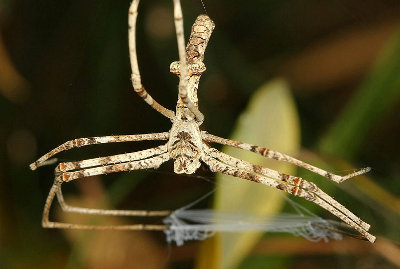Net-Casting Spider
Category: Arachnida Spider

Facts about Net-Casting Spiders, "Scientific name for Net-Casting Spider is Deinopis subrufa". Net-Casting spider is an Australian native. The name Net-Casting Spider comes for the species from its habit of creating a net that it stretches in front of its legs to catch prey, instead of weaving a much larger web that it resides upon.
Net casting spiders have stick like bodies and very thin legs. The Net-Casting Spider species holds its net in the front four legs while suspending itself with the back four legs, tucking its head down to make itself resemble a stick or leaf. The Net-Casting Spider will sometimes propel themselves toward the prey to catch it.
A Net-Casting spider or ogre-faced spider is part of the Deinopis genus and the Deinopidae family. All members of Deinopis have very large eyes on the front of the head plus six eyes so small in this species they are rarely noticed. The two very large black eyes are where it gets the resemblance to an ogre. Net-Casting Spider can be distinguished from the Avella genus by its larger eyes, and the fact that Avella spiders tend to have gray or greenish brown patterns. Net-casting spiders in the Deinopis genus range from light brown to dark brown but lack any patterning. The coloring of both groups of spiders allows them to blend in with their forest habitats in south-eastern Australia. Net casting spiders have a calamistrum instead of a spinneret to make its silk; this means the species is classified as cribellate.
The Net-Casting spider ranges from half an inch to a full inch (1.27 to 2.54 cm). Male Net-Casting Spider are smaller than the females. Females make a brown flecked egg sack that is suspended from foliage. The female Net-Casting Spider will cover it with leaf debris to better camouflage it.
Net-casting spiders are nocturnal. They will eat insects like ants and crickets and even other spiders. They will eat flies and other flying insects if they can catch it. The net-casting spiders sometimes splash droppings on the leaf or ground beneath it so that it can identify where the prey must be before it can be ensnared.
Net-Casting Spiders do not have a skeletons. They have a hard outer shell called an exoskeleton-(a rigid external covering for the body in some invertebrate animals). The exoskeleton is hard, so it can’t grow with the spider. The young Net-Casting Spiders need to shed their exoskeleton. The spider has to climb out of the old shell through the cephalothorax. Once out, they must spread themselves out before the new exoskeleton will harden. Know they have some room to grow. They stop growing once they fill this shell. Female spiders are usually bigger than males.
Net casting spiders are not poisonous to humans.
Spiders belong to a group of animals called "arachnids", mites and Scorpions and a tick is also in the arachnid family. An Arachnids is a creature with eight legs, two body parts, no antennae or wings and are not able to chew on food. Spiders are not insects because insects have three main body parts and six legs and most insects have wings.
The Arachnids are even in a larger group of animals called "arthropods" an invertebrate animal of the large phylum Arthropoda, which also include spiders, crustaceans and insects. They are the largest group in the animal world, about 80% of all animals come from this group. There are over a million different species. There are more than 40,000 different types of spiders in the world.
Net-Casting Spiders have oversize brains.
In the Net-Casting Spider the oxygen is bound to "hemocyanin" a copper-based protein that turns their blood blue, a molecule that contains copper rather than iron. Iron-based hemoglobin in red blood cells turns the blood red
Net-Casting Spiders have two body parts, the front part of the body is called the Cephalothorax-(the thorax and fused head of spiders). Also on this part of the body is the Net-Casting Spider’s gland that makes the poison and the stomach, fangs, mouth, legs, eyes and brain. Net-Casting Spiders also have these tiny little leg-type things called (pedipalps) that are next to the fangs. They are used to hold food while the Net-Casting Spider bites it. The next part of the Net-Casting Spiders body is the abdomen and the abdomens back end is where there is the spinnerets and where the silk producing glands are located.
The muscles in a Net-Casting Spiders legs pull them inward, but the spider can't extend its legs outward. It will pump a watery liquid into its legs that pushes them out. A Net-Casting Spider’s legs and body are covered with lots of hair and these hairs are water-repellent, which trap a thin layer of air around the body so the Net-Casting Spiders body doesn't get wet. It allows them to float, this is how some spiders can survive under water for hours. A Net-Casting Spider feels its prey with chemo sensitive hairs on its legs and than feels if the prey is edible. The leg hair picks up smells and vibrations from the air. There are at minimum, two small claws that are at the end of the legs. Each Net-Casting Spiders leg has six joints, giving the spider 48 leg joints. The Net-Casting Spider’s body has oil on it, so the spider doesn't stick to it’s own web.
A Net-Casting Spiders stomach can only take liquids, so a spider needs to liquefy their food before they eat. They bite on their prey and empty its stomach liquids into the pray which turns it into a soup for them to drink.
A male Net-Casting Spider has two appendages called "pedipalps" a sensory organ, instead of a penis, which is filled with sperm and insert by the male into the female Net-Casting Spider’s reproductive opening.

 Back To Category Arachnida Spider
Back To Category Arachnida Spider